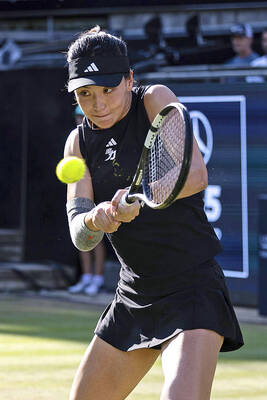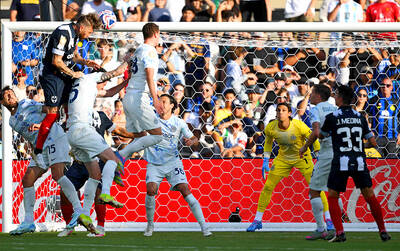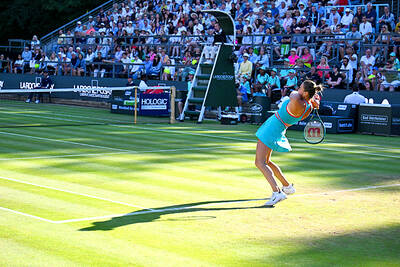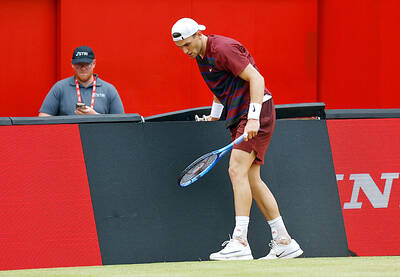Something strange happened the day after the US Open.
A black round cap about the size of a hockey puck mysteriously rose from the ground and started spraying water over Shinnecock Hills. In the golf industry, they call this a sprinkler.
Then a couple of players searched and found -- eureka! -- a pitch mark that needed to be repaired.
In other words, Shinnecock Hills returned to being a golf course, one of the finest in the country.
No one was sure what to call the links-styled course -- or the competition it held -- during a final round that identified the best players, humiliated the rest and set a US Open record for complaints.
There is no denying the US Golf Association, which treats par as its most precious commodity, went over the edge to make sure the toughest test in golf lived up to its reputation.
By continuing to double-cut the greens -- they were so dead, it's a wonder there was any grass left to mow -- and refusing to water them until certain holes became unplayable, the US Open more closely resembled a demolition derby than a national championship.
"Good shots are not staying in fairways. Good shots are not staying on greens," Tom Kite said. "You've got the best players in the world. If they can't shoot under par, then it's got to be out of control."
Robert Allenby had the best round at even-par 70.
Five players shot 79 and still moved up the leaderboard.
The 28 players who failed to break 80 included Ernie Els, the No. 2 player in the world.
"It's not the first time they've done this, and it won't be the last," Mark Calcavecchia said of the USGA, shortly after grinding out a 75. "On that note, I need a beer."
But for all the silliness Sunday, the lasting image is US Open champion Retief Goosen and runner-up Phil Mickelson playing a game unfamiliar to many others.
They were the only guys to beat par for the tournament.
They played the kind of golf that wins the US Open.
It's not about whether the golf course is fair. It's about shooting the lowest score.
Tee shots don't stay in the fairway? Mickelson only missed two of the last eight fairways. He played with such control that he used a variety of shots to keep the ball on the green and below the cup, giving himself a chance at birdie. His run of three birdies in four holes to briefly take the lead was sensational stuff.
After closing with 71, Lefty was asked if it was a fair test.
"I don't know what to say. I felt like I played some of the best golf of my life," he said. "I hit some of the best shots, I putted better than I probably ever have putted. And I still couldn't shoot par. So you tell me."
Then again, he would have shot 69 if not for that three-putt double bogey on the 17th that perhaps cost him the second leg of the Grand Slam.
Goosen showed incredible resiliency, if not poise. Almost as impressive as Mickelson's birdie run was the Goose saving par on No. 13, saving bogey on No. 14, and answering Mickelson with a birdie of his own on the 16th to regain a share of the lead. He took only 24 putts in the final round, and had no three-putts for the tournament.
"The way the course is set up, it's important to save pars," Goosen said. "I kept telling myself, `Keep playing for pars and you can win this event.' And it turned out that way."
One could argue that this is not how golf is meant to be played, but everyone played the same course.

Twelve days after winning her second Grand Slam title at the French Open, Coco Gauff fell at the first hurdle on grass in Berlin on Thursday as beaten Paris finalist Aryna Sabalenka advanced to the quarter-finals. Recipient of a first round bye, American Gauff lost 6-3, 6-3 to Chinese qualifier Wang Xinyu as world number one Sabalenka beat Rebeka Masarova 6-2, 7-6 (8/6) in her second round tie. Winner of 10 main tour titles, including the US Open in 2023 and the WTA Finals last year, Gauff has yet to lift a trophy in a grass-court tournament. “After I won the first

Sergio Ramos on Tuesday outfoxed two Inter players and artfully headed home the first goal for Monterrey at the FIFA Club World Cup. The 39-year-old Ramos slipped through the penalty area for the score just as he did for so many years in the shirts of Real Madrid and Spain’s national team, with whom he combined smarts, timing and physicality. Ramos’ clever goal and his overall defensive play at the Rose Bowl were major factors in Monterrey’s impressive 1-1 draw against the UEFA Champions League finalists in the clubs’ first match of the tournament. “There is always a joy to contribute to the

Top-ranked Aryna Sabalenka staged a “crazy comeback,” saving four match points before beating Elena Rybakina 7-6 (6), 3-6, 7-6 (6) in the quarter-finals of the Berlin Open on Friday. Sabalenka was 6-2 down in the final-set tie-breaker, but won six straight points to reach her eighth semi-final of the season. “Elena is a great player and we’ve had a lot of tough battles,” Sabalenka said. “I have no idea how I was able to win those last points. I think I just got lucky.” “I remember a long time ago when I was just starting, I won a lot of matches being down

While British star Jack Draper spent the past week trying to find rhythm and comfort in his first grass tournament of the season at the Queen’s Club Championships in London, Jiri Lehecka on Saturday bulldozed everything in his path. After more than two furious hours of battle, their form was reflected in the final scoreline as Lehecka toppled a frustrated Draper, the second seed, 6-4, 4-6, 7-5 to reach the biggest final of his career, against Carlos Alcaraz. Lehecka is also the first Czech to reach the men’s title match at Queen’s since Ivan Lendl lifted the trophy in 1990. Draper, who